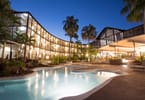Faced with discussions over sustainability and regulatory limitations, an increasing number of buildings in Lithuania are now undergoing adaptive reuse and transforming into modern and lively cultural spaces. From train stations to dredgers, to even a prison, repurposed buildings reveal how heritage can gain new life and become cultural relics for local communities and tourists.
Cities are tackling concerns about sustainability and even historic preservation as they focus their attention on abandoned buildings. A recent U.S. study revealed that the popularity of adaptive reuse — converting buildings that were once used for one purpose into other uses — has reached new heights.
Lithuania has also seen an uptick in repurposing various buildings, especially within the last decade. As urbanization continued to expand, formerly forgotten cafés, train platforms, and even a prison were given new life, banding together local communities as new cultural hotspots. Travelers visiting Lithuania have a unique opportunity to witness how the country’s past and present merge in the following repurposed spaces.
Drinks with Tony Soprano
A lively, industrial, and colorful bar by the name of PERONAS has taken rootright by the tracks near the old train station building in Vilnius. The station itself was built in 1950 and primarily functioned as a stop for travelers going from Saint Petersburg to Warsaw.
The bar now serves as a social meeting place, a sporadic art gallery, and the location of the infamous Tony Soprano statue that greets passengers as they arrive in the capital’s Station District, which was named as one of the coolest neighborhoods in the world by Time Out. Several other clubs and bars are located nearby, so the area could serve as a one-stop shop for a night out.
Former prison blends music, art, and historical heritage
Lukiškės Prison was built in Vilnius, the capital of Lithuania, in 1905. The brooding complex housed criminals and political prisoners who were deemed undesirable by political administrations that were in power at different times, such as Tsarist Russia, Nazi Germany, and the Soviets. Having been in use for a century, the complex stopped serving as a prison in 2019 and began operating as Lukiškės Prison 2.0.
The building is now a public gathering place for culture, creative expression, and community — housing over 250 artists, historical and art exhibitions, as well as multiple bars and an alternative concert venue. Various globally-known artists have performed at the venue — from the UK indie act King Krule to the German techno group Moderat — attracting locals and tourists alike to the century-old prison.
The prison has been transformed into the shooting grounds of Netflix’s show Stranger Things, whose fourth season was filmed on-site in the winters of 2020 and 2021.
The rebirth of industrial spaces
Housed in a former historic tape-recorder factory, a new cultural hub has emerged — the LOFTAS Art Factory — and is giving the industrial building a coat of fresh paint and ideas. Even though LOFTAS no longer produces any audio equipment, it nevertheless has a significant impact on the Lithuanian music scene.
The hub serves as a performance venue, giving emerging Lithuanian artists and small bands much-needed exposure, as well as hosting well-known performers from around the globe. Visitors are greeted by its free-spirited atmosphere before even entering the building, as its premises are covered by larger-than-life murals from contemporary artists.
Youthful energy by the seaside
One of Klaipėda’s — Lithuania’s biggest port city — brightest nighttime destinations lies right next to the seaport in an inactive industrial complex. Titled Hofas, it is a cultural space that captures the playful feel of a childhood spent hanging out with friends in the yard. Now a place for the grown-up rebellious kids to gather, the complex offers several bars — including the famous Herkus Kantas — along with a concert venue for visitors to enjoy.
The former ship docks are filled with experiences fit for a connoisseur of contemporary culture and entertainment — from locally-beloved indie music bands and arthouse film nights to renowned DJs and nightclub acts. In addition, an art gallery house called Tema, located facing the Danė River, features an exhibition space and housing for artists whose artwork and performances have become an inseparable part of the space. Workations, weekend yoga sessions, and a variety of other cultural projects also take place in several areas of Hofas.
The great ship of culture
Nemuno7 — located in the town of Zapyškis near Kaunas, Lithuania’s second-largest city — is the original name of a dredger used to deepen the riverbed of the Nemunas River. The solution to this unused and environmentally harmful ship came as a confluence of sustainability, nature, and culture. The original dredger remains intact with only minimal architectural additions, retaining the site’s authenticity.
Today, the revamped space houses eco-minded art exhibitions, interdisciplinary events, and other performances inspired by the energies of the legendary river that flows by it. Guided tours are available for those interested in learning the importance of Lithuania’s biggest river, its history, and how Nemuno7’s exhibitions reflect that.
At the very heart of Kaunas’ art scene
The Kaunas Picture Gallery, a branch of the M.K. Čiurlionis Art Museum, opened its doors in 1979. On its first floor were the main exhibition hall, the lobby, the cloakroom, and the café — which after more than thirty years were reborn as Kultūra.
Retaining the Fluxus-inspired spirit and authentic decor, the café is now a gathering spot for all types of characters — from bohemian youth to art lovers that have been customers since the gallery initially opened. One of the most beloved areas of Kultūra is its terrace and surrounding stairs, including the fountain area adjacent to the outside seating. Locals find a corner of the café that is dear to them and sip refreshing drinks as the unexpected events of the night unfold — from guests displaying their piano skills to an impromptu violin performance erupting from the crowd. The iconic green trolleybuses of Kaunas are also a sight to take in as they barrel down one of the city’s most significant streets.
WHAT TO TAKE AWAY FROM THIS ARTICLE:
- The bar now serves as a social meeting place, a sporadic art gallery, and the location of the infamous Tony Soprano statue that greets passengers as they arrive in the capital's Station District, which was named as one of the coolest neighborhoods in the world by Time Out.
- Housed in a former historic tape-recorder factory, a new cultural hub has emerged — the LOFTAS Art Factory — and is giving the industrial building a coat of fresh paint and ideas.
- The building is now a public gathering place for culture, creative expression, and community — housing over 250 artists, historical and art exhibitions, as well as multiple bars and an alternative concert venue.























